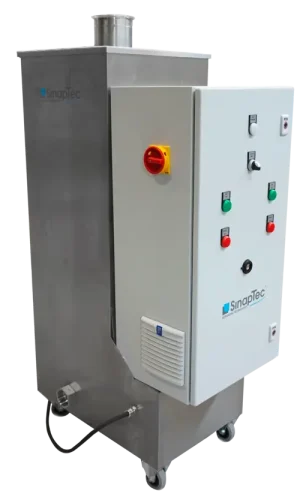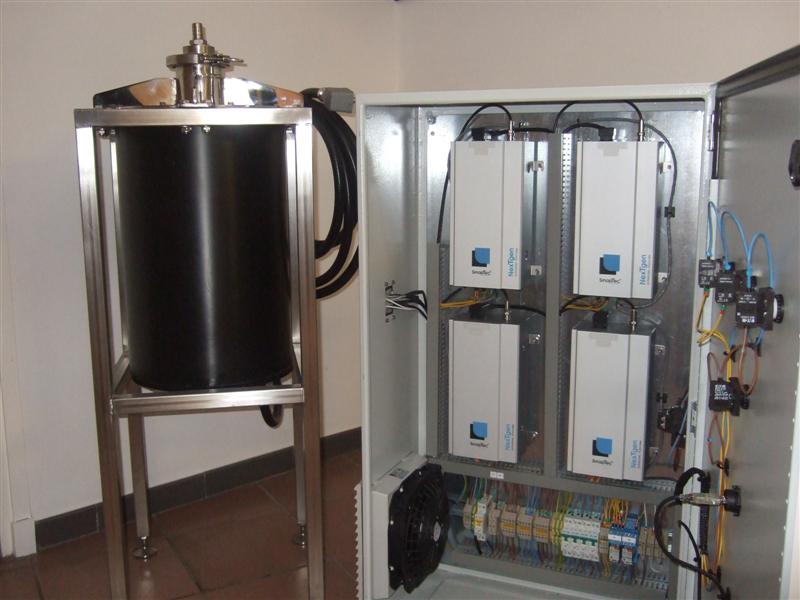Do you have a question about any of the products below? Need a quote or more information?
What Can Ultrasonic Liquid Processing Be Used For?
The industrial application of product treatment by ultrasound is rendered possible by our experience acquired in the course of numerous joint research projects with our partners in academia as well as the advancement of our equipments in the domain of high power. We have electronic modules of above 5kW in power which, when joined to transducers, enable a firm grip on the return on investment of your installations.
The hardware on offer by SinapTec is based on modules that allow for the treatment of fluids in continuous or in batch mode. We design the optimum industrial solution with the help of simulation and experimental models using laboratory and lab-scale equipment. These equipment are implemented at industrial scale for applications such as :
🔹Homogenization
Ultrasonic homogenization is primarily used to reduce the size of small particles in a liquid—whether solid or liquid—improving the uniformity and stability of the solution. Through high-frequency ultrasonic vibrations and cavitation effects, this technique effectively breaks down and disperses both soft and hard particles in a wide range of industrial applications.
🔹Emulsion
Ultrasonic emulsification refers to the process of mixing two (or more) immiscible liquids using ultrasonic energy to form a dispersed system. One liquid is uniformly distributed as fine droplets within the other, resulting in an emulsion.
This process is based on ultrasonic cavitation: the collapse of cavitation bubbles generates localized high temperatures and pressures, along with intense shock waves. These extreme conditions fragment the liquids into very fine droplets, which disperse efficiently in the other liquid phase.
🔹Dissolving
Ultrasonic dissolving is a process that uses ultrasonic energy to accelerate the dissolution of solutes into solvents. It is widely used in pharmaceutical preparation, cosmetics manufacturing, the food industry, and more.
The principle relies on cavitation generated by ultrasonic waves in liquid media, which enhances mass transfer and interactions between solute and solvent—significantly increasing dissolution rates, especially for poorly soluble substances or high-concentration systems.
🔹Extraction
Ultrasonic extraction is a technique used to extract active ingredients or other beneficial substances from animals, plants, microorganisms, etc.
Ultrasonic vibrations facilitate the rapid penetration of solvents into solid materials, so that the organic content is dissolved as fully as possible into the solvent, producing a mixed extract with multiple components.
Ultrasound enhances the extraction process by increasing extraction yield, reducing processing time and costs, and improving both product quality and output. This technology is widely used in the extraction of essential oils, pharmaceuticals, biodiesel, plant proteins, and more.
🔹Cell lysis
Ultrasonic cell lysis is an efficient technique that uses cavitation to break down cell walls and membranes, allowing the release of intracellular contents such as proteins, enzymes, DNA, and sugars.
It is widely applied in the pharmaceutical, food, environmental, and scientific research sectors—especially for plant tissues, microorganisms, and algae.
🔹Sonochemistry
Sonochemistry is a technology that uses ultrasonic energy to initiate or accelerate chemical reactions in liquids through cavitation effects. It is widely used in synthesis, decomposition, catalysis, and materials science.
Etc…
Our Ultrasonic Liquid Processing Equipment
Ultrasonic Pipe for Industry
Our pipe for Industry, in conjunction with our high-performance generator Incase 4kW, is the natural offshoot of our lab hardware range which combines a high level of power density with an excellent yield. Designed around a tube, it offers the major advantage of not disrupting the flow rate because the ultrasonic excitation takes place on the exterior. It is thus perfectly adapted to fluid media with high content of solids. As each application features its own distinctive characteristics, our engineers will be in charge of realizing the scale-up of your application.



Ultrasonic Rod Emitters for Industry
Derived from our laboratory range, our vibrating rod emitters for industry purposes, in conjunction with our generators Inside 4kW enable the deployment of the ultrasound technology in all manufacturing fields that are on the lookout for optimization potentials in their Liquid Processing.
Installed in batch mode or as loop device, the emission rods display a homogeneous distribution, a high level of performance in a compact volume and easy maintenance.
How Does Ultrasonic Liquid Processing Work?
Ultrasonic technology intensifies liquid-phase processes through acoustic cavitation. This phenomenon promotes mass transfer, mixing, and heat exchange. Ultrasonic piping systems harness and maintain this acoustic effect to achieve the desired processing results.
As a unit operation or final process step, the ultrasonic pipe insonifies the liquid indirectly, using transducers mounted outside the pipe. This means fluid flow is not disrupted by the equipment. Transducers can also be individually removed and replaced, minimizing both maintenance time and cost.
Advantages of Ultrasonic Liquid Processing
🔹 Efficiency & Speed
Ultrasound reduces reaction times while maintaining high-quality results.
🔹 Safety
This technology is low-risk and does not require high temperatures or pressures.
🔹 Versatility
Ultrasound can be applied to a wide range of liquids and processing steps.
🔹 Eco-Friendly & Sustainable
Ultrasonic processing generally involves fewer steps, uses less solvent, and works at moderate temperatures—ideal for thermosensitive compounds.
